Dogs & Trains
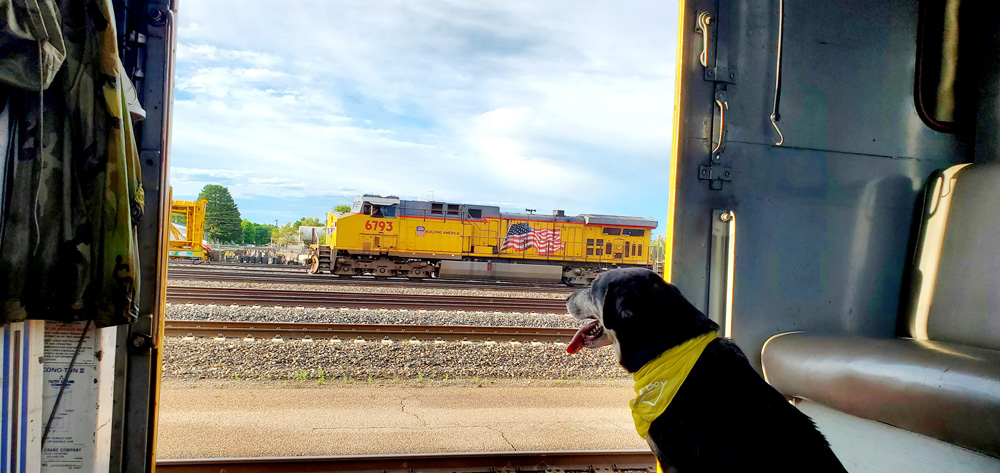
Dogs and trains, for some train enthusiasts, seem to go hand in hand (or hand in paw). But why is that? As a dog lover, I personally take my four-legged family member everywhere dogs are allowed to go. So naturally, this led me to question how many railfans actually take their dogs with them when they go watch and/or photograph trains. What does that look like, or more specifically, what is the proper protocol? Is it safe?
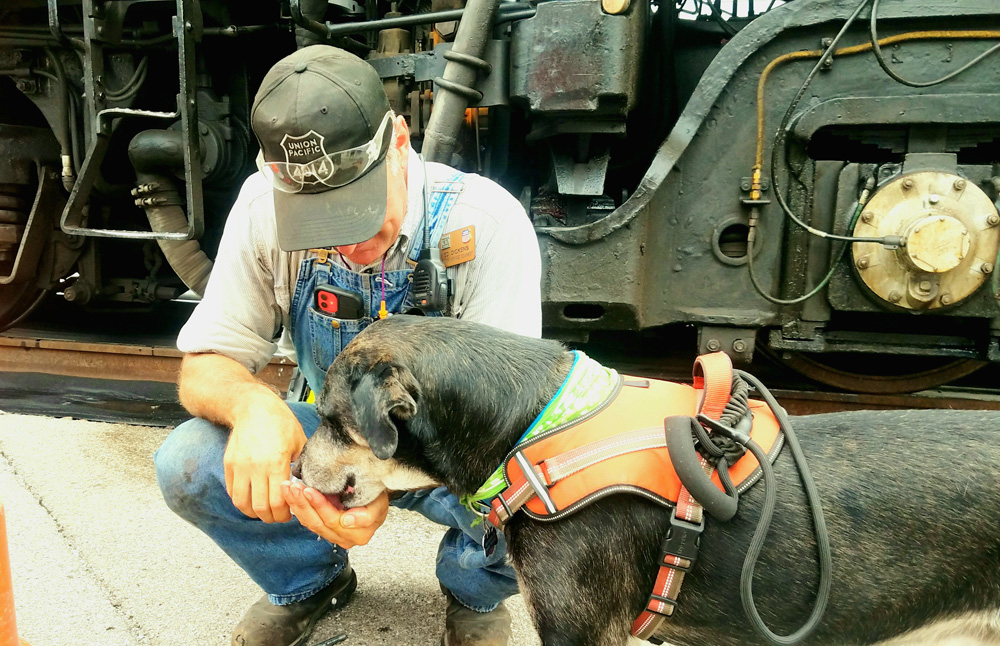
Late Trains Editor Jim Wrinn and his wife, Cate Kratville-Wrinn, always had a dog with them whenever possible. “People trackside with us frequently commented on our dogs and were always delighted to see them with us,” shares Cate. “Lexi was our first dog to go “raildogging.” After Lexi lost her battle with cancer on April 1, 2016, Jim and Cate got a new puppy they named Millie. Millie joined their family in October 2016.
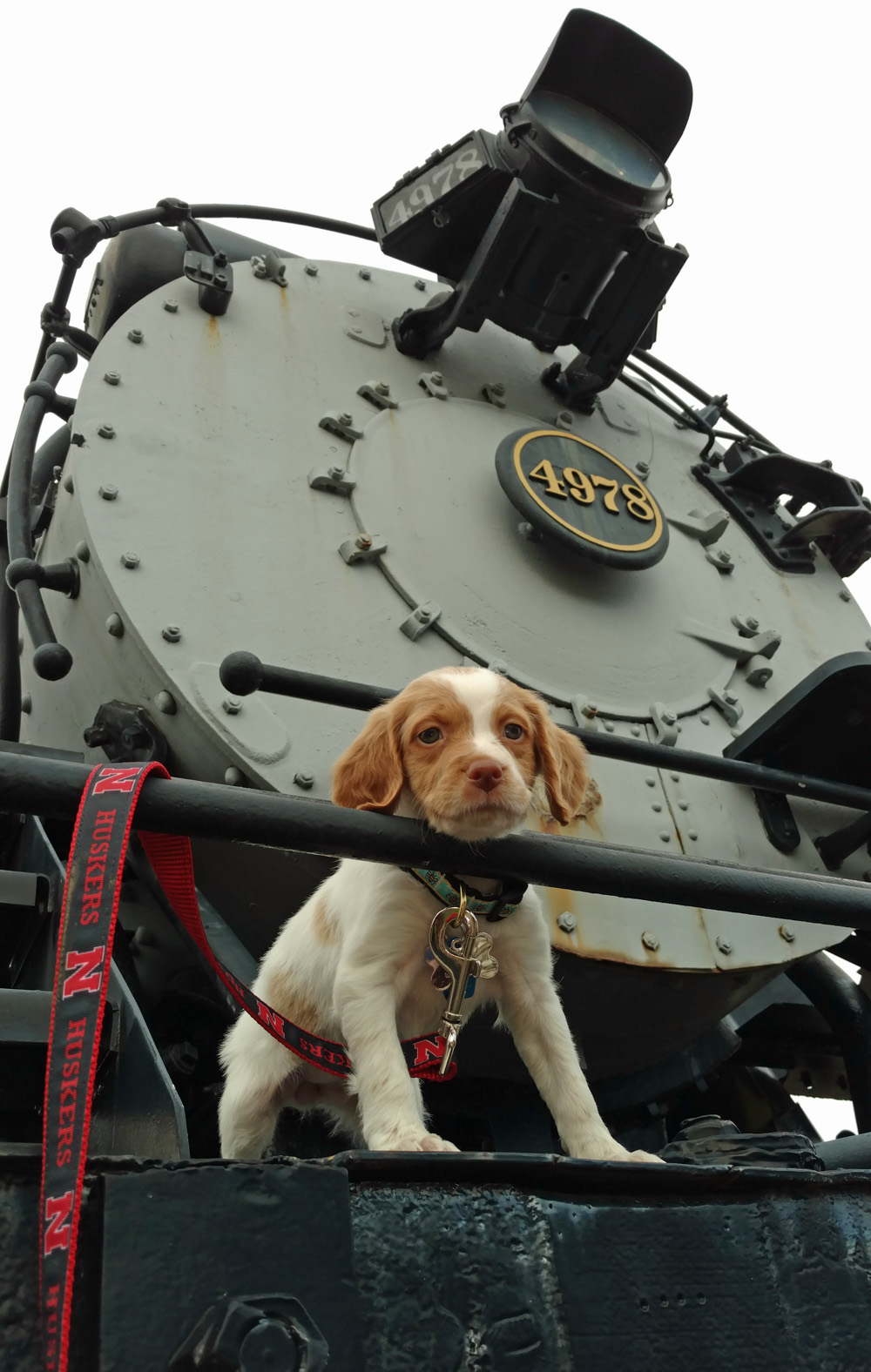
According to Cate, Jim couldn’t get enough of Millie in a train setting, even from the very start. “Within an hour of picking her up in Peoria, Ill., we had her on the pilot of an engine on display in a park! Then at Rochelle a couple hours later,” says Cate. “He [Jim] loved taking her with us on trips around the country. He also always took her with if we were railfanning around town … he was her human.”
Have you heard of the made-up term “raildogging?”
It’s the name Cate coined for a private Facebook page Jim created on Dec. 1, 2017. A social networking platform completely devoted to railfans and dog lovers, thus giving them a place to unite the two things they love most. Yup, you guessed it … trains and dogs.
I only joined the page a few months ago, yet I am constantly witnessing members posting pictures of their beloved canine companions in many different train-related settings. It’s awesome to see. This one dog in particular named Max (from the “Where is Max today?” Facebook page), has become quite a dog celebrity in the railfanning world. Or in this case, raildogging world.
Owner and lifelong railfan, Alan David, is a truck driver and as a job perk, Alan travels all over with his companion Max. “We travel 48 states and watch or ride trains whenever the chance arises,” says Alan. Depending on the restraints of your job, this may or may not be as feasible.
What are pros/cons to railfanning with your dog?
What makes this an appealing proposition to begin with? Here are a number of pros and cons supplied by dog-loving railfans.
Pro: Dogs encourage socialization. “Max has opened many doors for me, but not everyone likes dogs, and you need to realize this and act accordingly,” says Alan. Max is an extremely well-mannered dog, and he immediately comes up to you, so you can’t help but warm up to him quickly.
Scott Lothes, Center for Railroad Photography & Art president and executive director from Madison, Wis., has been railfanning since he was a teenager. He has been officially “raildogging,” since September 2015 when he and his wife, Maureen, adopted Maddie — a 20-pound Jack Russell/Rat Terrier mix. “She’s an instant icebreaker for anyone we meet, and dogs in general often put people at ease,” Scott says. “No one seems to care that I have a camera or even a drone when they’re focused on the dog.”
Con: Yet, dogs are not welcome everywhere. Alan stresses that if you are planning to railfan with your dog, don’t just expect to be able to take your dog everywhere. Some of the places Max and Alan have visited required months of planning and meetings before they were admitted in or on property. But nine times out of ten, Alan states that organizations will welcome Max back with open arms.
Pro: Dogs give you companionship. “My best trip with Maddie,” Scott recalls, “was an overnight campout by kayak at the former Santa Fe bridge over the Illinois River in Chillicothe, Ill. We paddled in from a river landing about 3 miles away, pitched the tent on a sandbar, and spent the night.” A trip filled with dozens of BNSF trains, beautiful scenery, and man’s best friend by his side — what more could anyone want. “Dogs are creatures that often want nothing more than to be with their people, and bringing Maddie with me when I’m railfanning is a great way to spend more time together. She enjoys riding in the car, and I especially appreciate her company during those long waits between trains.” notes Scott.
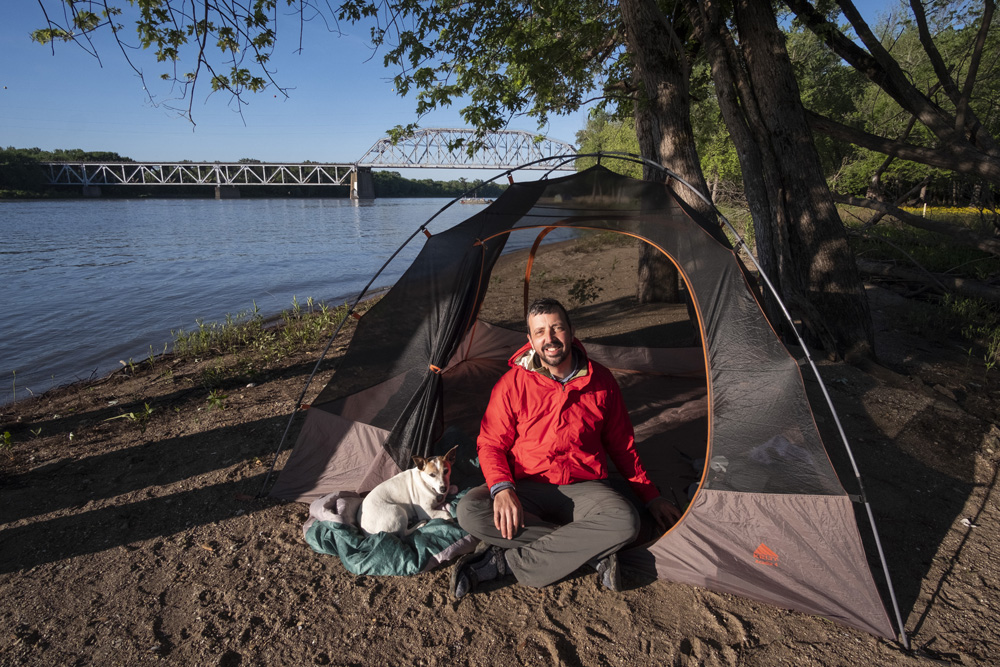
Con: However, dogs require additional planning and work. Scott cautions railfans to plan ahead — dogs have needs. Don’t leave them in the car for long periods of time without bathroom breaks or walks. “More than anything, know your dog,” says Scott. Take their needs into consideration alongside your own. He suggests the following:
- When exploring on foot bring your dog along
(avoid leaving you dog in the vehicle). - If planning an overnight trip, find pet-friendly lodging.
- Find a dog-friendly patio for dining (bring your dog’s food along).
- If your dog is not good with (or aggressive towards) strangers (or other animals) than adjust your trip accordingly.
Note: Be mindful of the temperature outside. Between 45 to 65 degrees Fahrenheit is generally okay. However, the car does get warmer (or colder) as time elapses. If 75 degrees outside, car may reach 100 degrees in 10 minutes. This may be life-threatening for your pet.
Best ways to stay safe
“No matter how well you know your dog, railfanning will put them in unusual situations (when you might be distracted by the train), and they may react in ways you don’t expect,” Scott explains. He advises folks to keep their dogs on a leash, especially around the tracks and roads. With 8 years of experience and trust under their belts, Scott still uses a harness and leash for Maddie.
No. 1: Leash your dog. Why take a chance. According to Scott, you can never know for sure if you’ll need to pull your dog out of a bad situation. Whether you know your dog or not, there are always variables. Your dog may “not be inclined to run away,” but another dog, or kid for instance, may distract your dog from those assumed rules. Which brings me to the next safety advisory.
No. 2: Train your dog. A dog that isn’t afraid of trains (sounds, movement, etc.) can only help make your railfanning experience better. “Dogs have great (and sensitive) hearing, and trains are loud,” says Mike Danneman, freelance photographer and railfan. He started by introducing Minturn (Beagle) slowly to various locations where trains were part of the scene yet were not too close.
Start by watching trains from a distance with your dog. Since Mike is a photographer, this conditioning was key. After Minturn was used to the sounds of trains, Mike could bring him closer to the tracks. However, Mike notes, “In the beginning, it’s a good idea to stay away from grade crossings. The incessant ringing of a crossing bell and loud approaching horn of a train will be too much for a dog experiencing its first train.”
Scott agrees and started working with Maddie immediately. “Maddie came on a railfanning trip to the Mississippi River barely a month after Maureen and I adopted her.” He kept a safe distance from the tracks until she got used to the sounds. Alan’s dog Max is a bit spooked by the moving trains after an experience with No. 1309, the ex-Chesapeake & Ohio 2-6-6-2 Mallet, which now runs on the Western Maryland Scenic Railroad. It must have been too much for him according to Alan. “I guess the Mallet just sounded too strange, plus it was working uphill, and he was on the outside of a curve, so to him it looked like it was coming right at him.” Now Alan stays further back with Max.
Another good lesson is teaching your dog, “wait.” This command, according to Mike, is very important, especially when you need a steady camera for photographing trains. Who really wants a dog tugging on their arm just when the perfect shot comes rolling by?
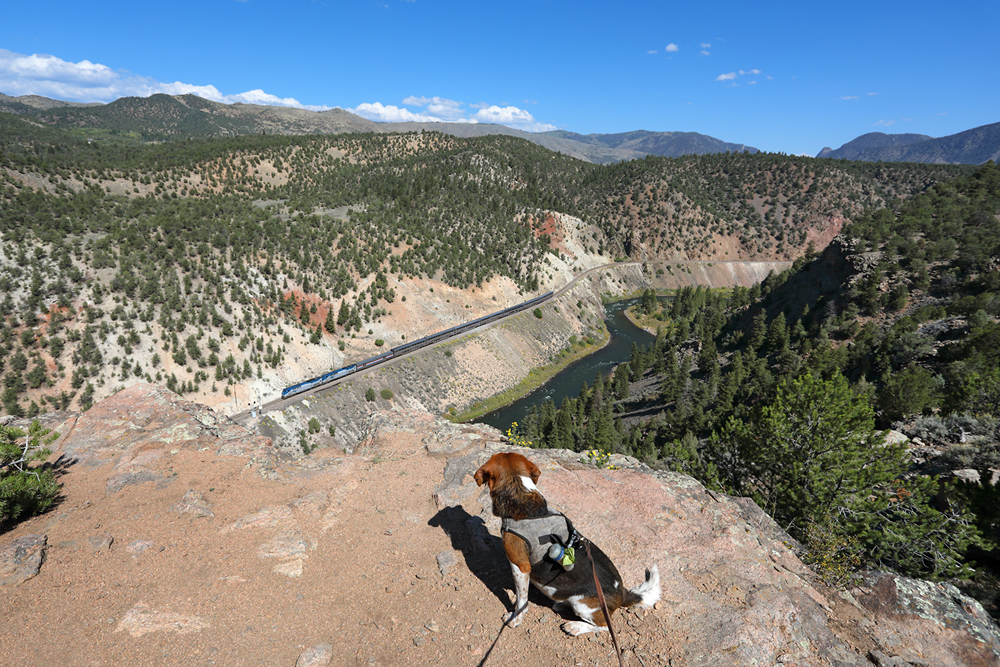
No. 3: Prepare for the unexpected. Taking your dog on a railfan trip is similar to bringing a small child along, says Mike, who had an emergency on one of his railfanning adventures. In 2022, he was on his annual two-week camping trip to Wyoming and Montana and essentially off the grid. Three days into his trip, while exploring some rock outcrops near Logan Hill, he was out walking Minturn, when the dog stuck his nose in a crevasse. “All I heard was a quick yelp,” says Mike. Minturn had been bit by something.
“I peered into the void, and sure enough, it was a rattlesnake. Some quick thinking by my camping buddies soon got us rolling south toward the nearest ‘big’ town. After a speedy trip southbound on Highway 59, he [Minturn] was stabilized by a vet in Douglas, Wyo., — about an hour after the bite. I then took him home to be fully treated by our local emergency vet in Arvada — it was on a Sunday, of course. Thankfully, he survived! A two-day detour home with my Beagle, and I headed back toward Montana to continue the trip.” Unfortunately, Minturn was not able to finish out the trip with Mike that time.
Remember, they are dogs
Overall, use common sense. Alan never forces Max to do stuff he’s not comfortable doing. And never reprimand them for not doing it either. Take their cues and adjust accordingly. Alan says, “Max will pose for a picture, but if he gets nervous, he will walk to me. I never scold him for this. Don’t try to make them something they aren’t.”
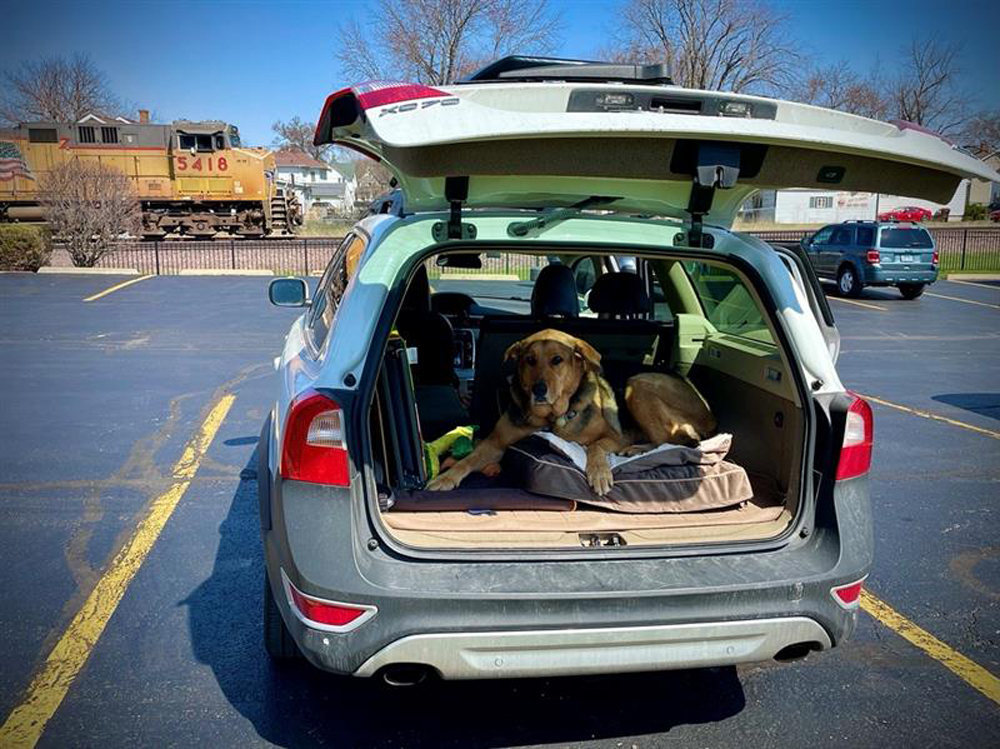
Pet supplies needed:
- Treats/food/water
- Waste bags (Clean-up after your pet. You’re a guest in someone else’s town, park, or field.)
- Chew toys/comfort items/bedding
- Leash/collar/harness/muzzle (The leash should be non-retractable — must have pet in control.)
- Tick removal device (I have one on my key ring — very useful!)
- Medical kit (Just in case.)
Note: Alan cautions, “On hot days, pay attention to ground temperature. You have shoes on, they don’t. If you are out in the brush and weeds, watch for snakes and check frequently for ticks. During a recent photo op while chasing No. 4014, Max picked up 30 ticks, and I pulled 10 off myself!”
………………..
P.S. — I appreciate everyone that contacted me about participating in this article. Thanks you for all the photos. I had a ton to work with.














O those doggies great job I’d be stressed taking my little guy lol
My dogs Gus and King had a good relationship with Conrail and then NS employees, but CSX was another story. I don’t know why, but they seemed to go out of their way to be aggressive about basically nonsense. One time I parked about 6″ over the property line in Walbridge and I got trespassed without getting out of my car. CR employees would take me to see wrecks in the yard, and quite a few of them brought Gus and King snacks and visited with them. The yards were only a short distance away from each other, but it was like a different world. I spent a lot of hours at the tracks with both dogs, especially Gus, and I miss those times. Cats just don’t work.
I would not even DREAM of railfanning with my cat!!!! He’s an orange tabby who is part Bengal (yes, I’ve had DNA done on him) – very active, very playful, and a bit skittish around strange noises.